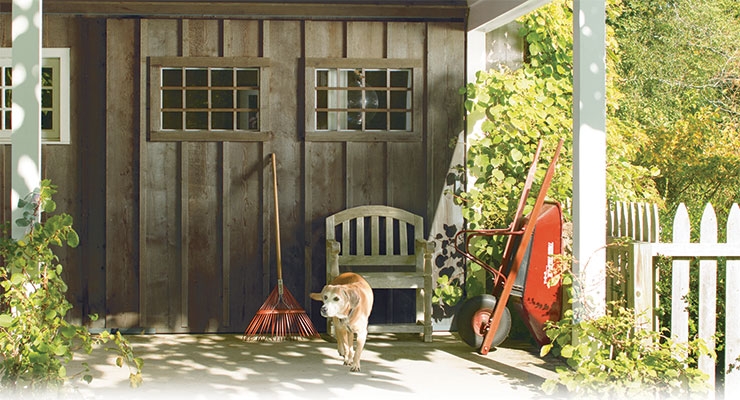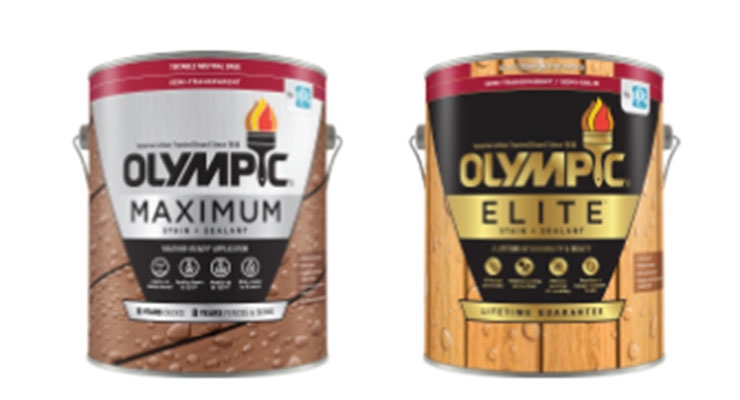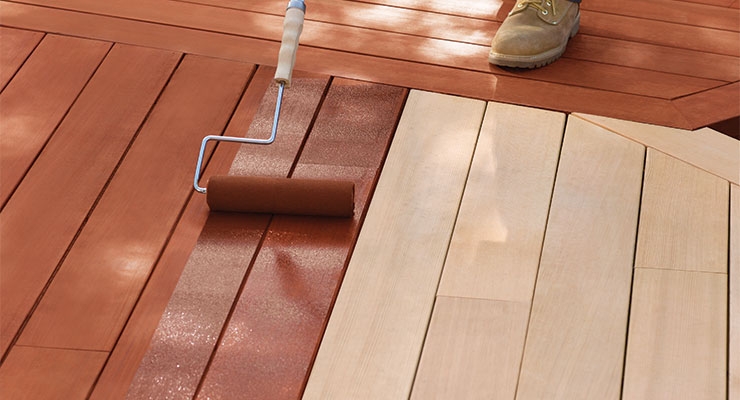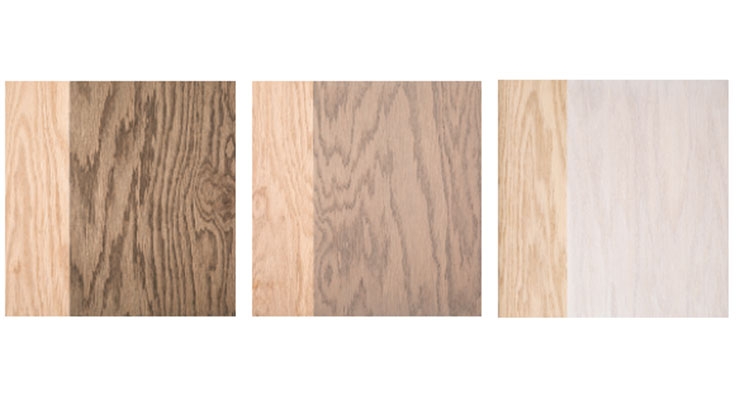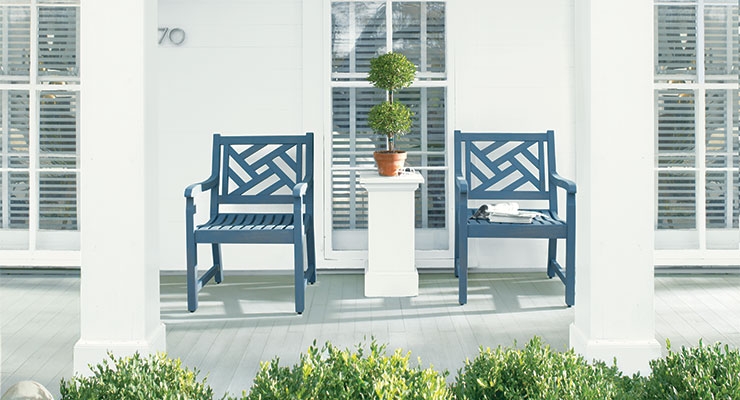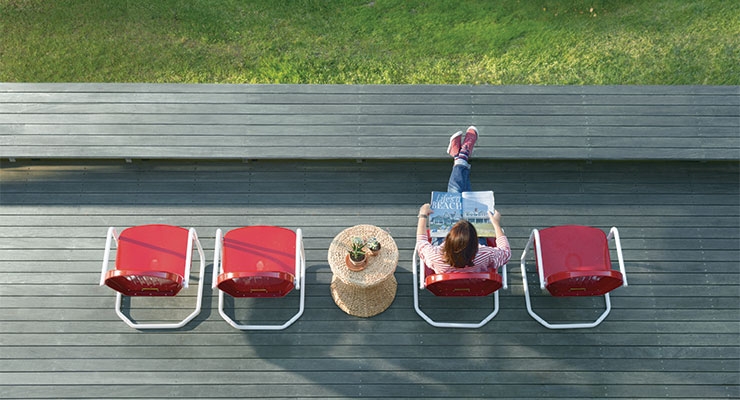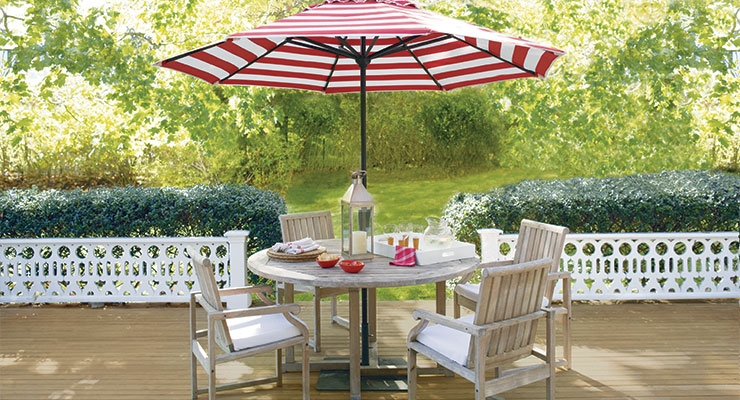Anthony Locicero, Associate Editor02.19.20
The global wood coatings market was valued at $7.8 billion in 2018 and is projected to reach $11.98 billion by 2025, growing at a CAGR of 6.3 percent from 2020 to 2025, according to Allied Market Research.
Wood coatings manufacturers reported growth in 2019.
“Overall, the wood coatings market continues to grow and is expected to continue for the next several years. In general, wood and natural surfaces continue to remain a popular element in interior décor and furniture,” said Jessica Bahn, brand manager at Rust-Oleum.
“Last year was a solid year for the wood coatings market since it’s now easier than ever for customers to purchase stain and tackle DIY [do it yourself] projects,” said Rick Bautista, director of product marketing, wood coatings group, Behr Paint Company.
The housing market has played an important role in the growth of the wood coatings market, according to Bahn and Bautista.
“The housing market, while going through change, continued to grow and drive home renovation and improvement,” Bahn said. “Many Baby Boomers are choosing to remain in their current home once they retire and adapt the home they have which often requires updating wood surfaces to bring their home up to date. Millennials’ homeownership is still low but expected to grow over the next five years. Within younger audiences, personalization and a willingness to DIY bode well for the years ahead.”
Two of Behr’s premium wood stain and sealer products exceeded sales goals, “likely due to the fact that homeowners are staying in their homes longer and giving their aging decks much needed attention,” Bautista reported.
“As we look to the next decade, we expect the wood coatings industry to continue thriving as DIYers seek out unique projects that involve our wood stains and finishes,” he added.
However, “the market for wood coatings continues to face challenges in different regions and applications,” said Anthony Woods, AkzoNobel segment marketing director, wood coatings.
“Interest rates remain at an all-time low,” Woods continued. “This makes it more attractive for consumers to invest. However, an overall slow-down in the economy is likely to affect consumer confidence and their willingness to invest in new builds or home improvements.
“We expect both new build and renovation, maintenance and improvement markets to slow down in the short to mid-term.”
There was a “gradual slowdown” in the global furniture market throughout 2019, Woods reported, adding a “slow recovery” is expected in 2020.
“There is still some volatility due to the impact of the recent U.S.-China trade impasse, with U.S. importers looking for alternative manufacturing locations other than in China,” he said. “Vietnam has benefited from this, and the market there is still growing strong. There is also strong growth in other Southeast Asian countries. The market for products manufactured in Asia for non-U.S. destinations is stable, achieving expected levels of growth.”
The increase in consumer’s disposable income and an improvement in the standard of living in developing economies such as India and China are fueling the demand for modern furniture, which in turn is expected to drive the demand for wood coatings, Allied Market Research reported.
Per Allied Market Research, Asia-Pacific accounts for the major share in the global wood coatings market, owing to an increase in demand for wood coatings from emerging application sectors, including furniture, joinery, flooring, and others.
Key drivers
One key market driver is the housing market, “as people look to update their homes to sell or customize their purchased homes to themselves,” Rust-Oleum’s Bahn said.
“New home construction and home re-modeling projects continue to shape the demand for cabinets, furniture, flooring and especially building products,” said AkzoNobel’s Woods. “Architecture, home design and lifestyle trends influence home interiors and drive the appeal for the open home concept. Within North America, the kitchen remains the center of the home for gatherings, and open living areas give way to outdoor spaces.”
“Furniture sold in high-end stores, and home décor featured in media impact color trends,” Bahn added.
DIY projects will also fuel growth.
“The convenience of grab-and-go wood stain and finish products in The Home Depot stores has contributed to the market’s success because these offerings simplify the shopping experience,” said Behr’s Bautista. “Instead of having to wait at the paint desk, customers can conveniently grab premixed stains and finishes directly from store shelves.”
“DIYers invest in stain products that have proven to be consistent and dependable,” said Jill Lamont, PPG senior marketing manager, Olympic stain by PPG. “Our research shows that a consumer takes on a project in order to protect a wood surface or waterproof an existing wood surface. Oftentimes, stain projects are not meant to drastically change the look of a space, however, the right stain color can enhance the natural appearance of wood. Consumers select their stain color to match what color they already have on their deck or fence.”
Added Bahn: “The popularity of fixing-it-up, before/after projects on social media and TV promote a DIY mentality bringing new people into the wood care space.”
Performance and quality are also key market drivers, according to a team of Benjamin Moore experts. That goes hand-in-hand with the ease of application and color, the experts noted.
“Additionally, sourcing and availability become especially important in smaller shops where the convenience of buying a few gallons at a time is critical,” they added.
While Allied Market Research reported overall growth, factors such as stringent environmental rules imposed by the government and other regulatory bodies on the use of volatile organic compounds (VOC) in the production of wood coating hamper the growth of the wood coatings market, it also noted.
“This is attributed to the fact that increased use of VOCs in the production of wood coatings has a harmful impact on the environment,” Allied Market Research wrote in its May 2019 wood coatings market report. “In addition, volatile raw material prices hinder the wood coatings market growth. On the other hand, advancement in coatings technology and surge in the use of radiation cure coatings are some of the factors that provide lucrative opportunities in the wood coating market.”
“The manufacture and use of water-based and low-VOC coatings have been adopted across the country over the past few years,” PPG’s Lamont said.
“Regulations continue to become more stringent for products and shoppers are increasingly conscious of what is in their products,” Bahn added.
PPG’s Olympic ELITE and Olympic Maximum stain lines include low VOC and nationally compliant products sold in regulated markets, Lamont said.
“All low-VOC and nationally compliant products under Olympic Elite and Olympic Maximum feature a unique and innovative hybrid formula, which includes a fast-drying multi-coat, a penetrating protective barrier and color clarity, to deliver the benefits of both a water-based stain and an oil-based stain,” she added.
Rust-Oleum has its Water-Based Ultimate Polyurethane, which Bahn said has been a top-selling product “for years.”
“We can all expect demand for other water-based products to continue and over time the volume will shift further from classic oil-based products to low-VOC versions of oil-based products and water-based,” Bahn added.
“A majority of our wood stains and finishes are water-based and low VOC, which is partially due to the industry’s increased use of these types of coatings that began years ago,” Behr’s Bautista said. “With that being said, we know some customers still seek oil-based coatings, which is why we continue to offer quality products that meet their needs too.”
Benjamin Moore experts said consumers want water-based products that are easy to clean, environmentally friendly, and just as durable as traditional high-performance alkyd coating.
“It is, however, important to note that in many cases, adhering to increased manufacturing and product regulations make improving product performance challenging,” they cautioned. “This demand has sparked a flurry of innovation throughout the last several years to not only meet this consumer demand but also to exceed consumer expectations in terms of product quality.”
Trends
AkzoNobel’s Global Color and Design team for Wood Coatings works with designers and architects to understand and interpret the impact of fashion and lifestyle on colors and effects used in paints and coatings, according to Woods.
“2020 is the start of a new decade. Our trend research has shown that while the world is full of great possibilities, it is also a time of confusion, where we crave meaning,” he continued. “We need to ask ourselves, ‘How can we best live in the present?’ ‘How can we influence our future?’ ‘What makes us unique?’ ‘What makes us human?’ It’s ‘the human touch.’
“In 2020, we will see less physical wire brushing and sandblasting and a movement towards incorporating other textures, such as linens and shagreen effects, into some designs,” Woods concluded.
Popular trends Rust-Oleum has observed include the continued popularity of whitewashing and a “time-worn,” vintage look; a comeback of lighter wood tones – supported by Bohemian and Scandinavian trends in interior décor; matte and less-glossy finishes growing in demand; and additionally, an ongoing demand for easy to use products that dry faster and provide “impressive” durability.
In terms of colors, red and yellow-based browns are still out of favor and continue to decline, Bahn said.
“Gray continues to be a trend loved by consumers, and we will see a transition to more warmer grays going forward,” Woods said.
“True” rich brown and gray tones have “proven longevity in the market and expected to remain popular for the time being,” Bahn said.
On the flip side, “Consumers are shifting away from previously popular gray stains, and instead are choosing warmer, earthy-toned stains that inspire balance and help them feel connected to nature,” Lamont said. “Warmer wood tones instantly humanize any space, a characteristic that is fueling the momentum behind this growing trend.”
“Darker, richer colors continue to grow in popularity compared to lighter, natural wood colors,” Bautista said. “Shades of brown in particular are trending and are among some of our most sought out tinted colors. Additionally, opaque/solid color stains are on the rise as more homeowners seek products that thoroughly cover up imperfections in aging decks.”
According to the team of Benjamin Moore experts, color trends and customer preference continue to drive category purchase decisions.
“For floors, dark transparent stains have been and continue to be the trend,” they noted. “On cabinets, the industry has moved from transparent stains to opaque colors most often in lighter colors (i.e. off-whites, grays), to contrast with the darker color floors. Both floors and cabinets have trended to dull/matte finishes which help hide imperfections on dark colors and opaque surfaces.”
Product performance and customer expectations
What do customers ask for in terms of product performance?
“Our customers are concerned with aesthetics and scratch and stain resistance,” Wood said. “They also want to reduce their total cost of ownership, which means purchasing products that can remove process or costly labor steps while increasing their overall production capacity, therefore reducing costs.
“Some customers are opting for more sustainable coatings and are actively looking to AkzoNobel wood coatings to provide products with outstanding protection and unrivaled beauty alongside environmental benefits,” Woods continued.
“Customers expect quality, durability, color options and innovation from our wood products,” Bautista said. “They’re investing time and money into their homes, so it’s important we deliver quality products that stand the test of time.”
“Consumers want stains that are durable and live up to their claims, specifically claims about waterproofing protection,” Lamont said. “Staining is a project consumers are likely to tackle about every three years, so they strongly base their purchasing decision on product reviews and which products make the staining process quick and easy.”
“Color remains the No.1 thing people shop wood stain by, followed by speed to complete a project and durability,” Bahn added.
“Our customers are looking for products that not only solve a problem with ease but also perform at a level that is expected from a premium coatings company like Benjamin Moore,” the Benjamin Moore experts stated. “Customers are asking for increased product performance in areas such as resistance to normal household chemicals, water/moisture, food/ staining and chipping/marring. Also, customers are looking for products with faster dry times or fewer coats needed for application as they save time.”
Wood coatings manufacturers reported growth in 2019.
“Overall, the wood coatings market continues to grow and is expected to continue for the next several years. In general, wood and natural surfaces continue to remain a popular element in interior décor and furniture,” said Jessica Bahn, brand manager at Rust-Oleum.
“Last year was a solid year for the wood coatings market since it’s now easier than ever for customers to purchase stain and tackle DIY [do it yourself] projects,” said Rick Bautista, director of product marketing, wood coatings group, Behr Paint Company.
The housing market has played an important role in the growth of the wood coatings market, according to Bahn and Bautista.
“The housing market, while going through change, continued to grow and drive home renovation and improvement,” Bahn said. “Many Baby Boomers are choosing to remain in their current home once they retire and adapt the home they have which often requires updating wood surfaces to bring their home up to date. Millennials’ homeownership is still low but expected to grow over the next five years. Within younger audiences, personalization and a willingness to DIY bode well for the years ahead.”
Two of Behr’s premium wood stain and sealer products exceeded sales goals, “likely due to the fact that homeowners are staying in their homes longer and giving their aging decks much needed attention,” Bautista reported.
“As we look to the next decade, we expect the wood coatings industry to continue thriving as DIYers seek out unique projects that involve our wood stains and finishes,” he added.
However, “the market for wood coatings continues to face challenges in different regions and applications,” said Anthony Woods, AkzoNobel segment marketing director, wood coatings.
“Interest rates remain at an all-time low,” Woods continued. “This makes it more attractive for consumers to invest. However, an overall slow-down in the economy is likely to affect consumer confidence and their willingness to invest in new builds or home improvements.
“We expect both new build and renovation, maintenance and improvement markets to slow down in the short to mid-term.”
There was a “gradual slowdown” in the global furniture market throughout 2019, Woods reported, adding a “slow recovery” is expected in 2020.
“There is still some volatility due to the impact of the recent U.S.-China trade impasse, with U.S. importers looking for alternative manufacturing locations other than in China,” he said. “Vietnam has benefited from this, and the market there is still growing strong. There is also strong growth in other Southeast Asian countries. The market for products manufactured in Asia for non-U.S. destinations is stable, achieving expected levels of growth.”
The increase in consumer’s disposable income and an improvement in the standard of living in developing economies such as India and China are fueling the demand for modern furniture, which in turn is expected to drive the demand for wood coatings, Allied Market Research reported.
Per Allied Market Research, Asia-Pacific accounts for the major share in the global wood coatings market, owing to an increase in demand for wood coatings from emerging application sectors, including furniture, joinery, flooring, and others.
Key drivers
One key market driver is the housing market, “as people look to update their homes to sell or customize their purchased homes to themselves,” Rust-Oleum’s Bahn said.
“New home construction and home re-modeling projects continue to shape the demand for cabinets, furniture, flooring and especially building products,” said AkzoNobel’s Woods. “Architecture, home design and lifestyle trends influence home interiors and drive the appeal for the open home concept. Within North America, the kitchen remains the center of the home for gatherings, and open living areas give way to outdoor spaces.”
“Furniture sold in high-end stores, and home décor featured in media impact color trends,” Bahn added.
DIY projects will also fuel growth.
“The convenience of grab-and-go wood stain and finish products in The Home Depot stores has contributed to the market’s success because these offerings simplify the shopping experience,” said Behr’s Bautista. “Instead of having to wait at the paint desk, customers can conveniently grab premixed stains and finishes directly from store shelves.”
“DIYers invest in stain products that have proven to be consistent and dependable,” said Jill Lamont, PPG senior marketing manager, Olympic stain by PPG. “Our research shows that a consumer takes on a project in order to protect a wood surface or waterproof an existing wood surface. Oftentimes, stain projects are not meant to drastically change the look of a space, however, the right stain color can enhance the natural appearance of wood. Consumers select their stain color to match what color they already have on their deck or fence.”
Added Bahn: “The popularity of fixing-it-up, before/after projects on social media and TV promote a DIY mentality bringing new people into the wood care space.”
Performance and quality are also key market drivers, according to a team of Benjamin Moore experts. That goes hand-in-hand with the ease of application and color, the experts noted.
“Additionally, sourcing and availability become especially important in smaller shops where the convenience of buying a few gallons at a time is critical,” they added.
While Allied Market Research reported overall growth, factors such as stringent environmental rules imposed by the government and other regulatory bodies on the use of volatile organic compounds (VOC) in the production of wood coating hamper the growth of the wood coatings market, it also noted.
“This is attributed to the fact that increased use of VOCs in the production of wood coatings has a harmful impact on the environment,” Allied Market Research wrote in its May 2019 wood coatings market report. “In addition, volatile raw material prices hinder the wood coatings market growth. On the other hand, advancement in coatings technology and surge in the use of radiation cure coatings are some of the factors that provide lucrative opportunities in the wood coating market.”
“The manufacture and use of water-based and low-VOC coatings have been adopted across the country over the past few years,” PPG’s Lamont said.
“Regulations continue to become more stringent for products and shoppers are increasingly conscious of what is in their products,” Bahn added.
PPG’s Olympic ELITE and Olympic Maximum stain lines include low VOC and nationally compliant products sold in regulated markets, Lamont said.
“All low-VOC and nationally compliant products under Olympic Elite and Olympic Maximum feature a unique and innovative hybrid formula, which includes a fast-drying multi-coat, a penetrating protective barrier and color clarity, to deliver the benefits of both a water-based stain and an oil-based stain,” she added.
Rust-Oleum has its Water-Based Ultimate Polyurethane, which Bahn said has been a top-selling product “for years.”
“We can all expect demand for other water-based products to continue and over time the volume will shift further from classic oil-based products to low-VOC versions of oil-based products and water-based,” Bahn added.
“A majority of our wood stains and finishes are water-based and low VOC, which is partially due to the industry’s increased use of these types of coatings that began years ago,” Behr’s Bautista said. “With that being said, we know some customers still seek oil-based coatings, which is why we continue to offer quality products that meet their needs too.”
Benjamin Moore experts said consumers want water-based products that are easy to clean, environmentally friendly, and just as durable as traditional high-performance alkyd coating.
“It is, however, important to note that in many cases, adhering to increased manufacturing and product regulations make improving product performance challenging,” they cautioned. “This demand has sparked a flurry of innovation throughout the last several years to not only meet this consumer demand but also to exceed consumer expectations in terms of product quality.”
Trends
AkzoNobel’s Global Color and Design team for Wood Coatings works with designers and architects to understand and interpret the impact of fashion and lifestyle on colors and effects used in paints and coatings, according to Woods.
“2020 is the start of a new decade. Our trend research has shown that while the world is full of great possibilities, it is also a time of confusion, where we crave meaning,” he continued. “We need to ask ourselves, ‘How can we best live in the present?’ ‘How can we influence our future?’ ‘What makes us unique?’ ‘What makes us human?’ It’s ‘the human touch.’
“In 2020, we will see less physical wire brushing and sandblasting and a movement towards incorporating other textures, such as linens and shagreen effects, into some designs,” Woods concluded.
Popular trends Rust-Oleum has observed include the continued popularity of whitewashing and a “time-worn,” vintage look; a comeback of lighter wood tones – supported by Bohemian and Scandinavian trends in interior décor; matte and less-glossy finishes growing in demand; and additionally, an ongoing demand for easy to use products that dry faster and provide “impressive” durability.
In terms of colors, red and yellow-based browns are still out of favor and continue to decline, Bahn said.
“Gray continues to be a trend loved by consumers, and we will see a transition to more warmer grays going forward,” Woods said.
“True” rich brown and gray tones have “proven longevity in the market and expected to remain popular for the time being,” Bahn said.
On the flip side, “Consumers are shifting away from previously popular gray stains, and instead are choosing warmer, earthy-toned stains that inspire balance and help them feel connected to nature,” Lamont said. “Warmer wood tones instantly humanize any space, a characteristic that is fueling the momentum behind this growing trend.”
“Darker, richer colors continue to grow in popularity compared to lighter, natural wood colors,” Bautista said. “Shades of brown in particular are trending and are among some of our most sought out tinted colors. Additionally, opaque/solid color stains are on the rise as more homeowners seek products that thoroughly cover up imperfections in aging decks.”
According to the team of Benjamin Moore experts, color trends and customer preference continue to drive category purchase decisions.
“For floors, dark transparent stains have been and continue to be the trend,” they noted. “On cabinets, the industry has moved from transparent stains to opaque colors most often in lighter colors (i.e. off-whites, grays), to contrast with the darker color floors. Both floors and cabinets have trended to dull/matte finishes which help hide imperfections on dark colors and opaque surfaces.”
Product performance and customer expectations
What do customers ask for in terms of product performance?
“Our customers are concerned with aesthetics and scratch and stain resistance,” Wood said. “They also want to reduce their total cost of ownership, which means purchasing products that can remove process or costly labor steps while increasing their overall production capacity, therefore reducing costs.
“Some customers are opting for more sustainable coatings and are actively looking to AkzoNobel wood coatings to provide products with outstanding protection and unrivaled beauty alongside environmental benefits,” Woods continued.
“Customers expect quality, durability, color options and innovation from our wood products,” Bautista said. “They’re investing time and money into their homes, so it’s important we deliver quality products that stand the test of time.”
“Consumers want stains that are durable and live up to their claims, specifically claims about waterproofing protection,” Lamont said. “Staining is a project consumers are likely to tackle about every three years, so they strongly base their purchasing decision on product reviews and which products make the staining process quick and easy.”
“Color remains the No.1 thing people shop wood stain by, followed by speed to complete a project and durability,” Bahn added.
“Our customers are looking for products that not only solve a problem with ease but also perform at a level that is expected from a premium coatings company like Benjamin Moore,” the Benjamin Moore experts stated. “Customers are asking for increased product performance in areas such as resistance to normal household chemicals, water/moisture, food/ staining and chipping/marring. Also, customers are looking for products with faster dry times or fewer coats needed for application as they save time.”

